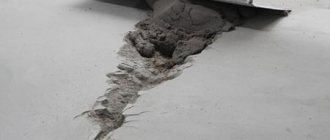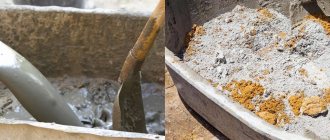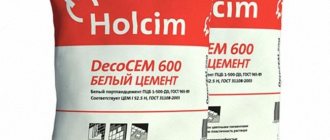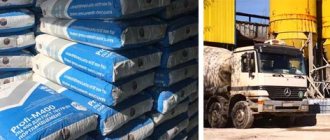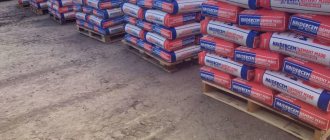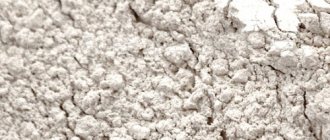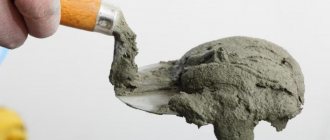Classification by properties
Expanding cements are a group of building materials that have distinctive technical characteristics and qualities. They can be classified according to their properties and the raw materials used, which determine the final properties and behavior of the mixture:
- Aluminous varieties are able to increase in volume during hydration, which allows them to maintain the correct shape without cracks, deformations with slight shrinkage.
- Non-shrinkable materials increase in volume as they harden, but when they reach their final strength indicators, they do not change in size.
- The tension type is effective in the construction of reinforced concrete structures.
The 3 listed varieties contain Portland clinker cement with various blast furnace slags, gypsum, and other additives.
To achieve an expanding effect, the following additives are used:
- Aluminum connections.
- Magnesium reagents.
The increase in volume is also due to the presence of gypsum, which reacts with the liquid. Expanding Portland cement retains its strength and even becomes denser. This gives it a number of advantages over traditional porous concrete.
The prestressing type acts as a tensile agent because it is capable of elongating reinforced frames during the process of hydration, providing internal tension to the steel and increasing the load-bearing capacity of the structure.
Processing stones at home
They are made in the form of faceplates and are manual. The lapping material for stone processing is different. It can be cast iron, tin, lead, wood, fluoroplastic, hematite, chalcedony. The laps themselves, as a rule, perform fine grinding, and moistened chromium oxide or GOI paste is added for polishing.
Instead of chromium oxide, you can use green paint under the same name, since chromium oxide is its main component. You can polish it using a leather swab. The disadvantage of chromium oxide and GOI paste is that they eat into the cracks of the stone and are washed out with difficulty, using gasoline. Aluminum oxide powders are also used for polishing.
Do It Yourself Young Technician - for Skilled Hands Young Technician - for Skilled Hands, page Picture Text. The power of the EZS-1 device is 0.25 kW, rotation speed min. - Other electric motors can be used for stone processing in the power range from 0.25 to 0.5 kW and rotation speed from 15C0 to min. POLISHING The main tools for this final operation in stone processing are laps, polishing wheels made of felt and cloth, as well as brushes - hair or from plant materials such as jute.
Soft- U. Previous page Next page Information related to this page: How to sharpen a saw?
Advantages
Self-expanding cement is in demand due to the following operational advantages:
- Increased adhesive properties and uniform expansion, promoting a tight fit of the solution to the base and gradual filling of voids and cracks.
- Improved resistance to negative temperatures. Due to minimal water absorption, the binder component can withstand up to 1500 freeze-thaw cycles.
- Resistance to temperature fluctuations.
- Possibility of implementing construction activities during the cold period.
- Invulnerability to the negative effects of atmospheric or chemical factors.
Flaws
However, in addition to the advantages, expanding cement can also have negative qualities. These include:
- The high cost of products in comparison with options for domestic and general construction use.
- Short shelf life. It ranges from 1 to 3 months in a sealed bag.
- Limited production volume. To receive a large batch, you must place a personal order.
- High probability of purchasing low-quality analogues and fakes.
- A number of difficulties during installation. Since the main properties of expanding mortars appear as a result of hardening under the influence of liquid, during the first few days concrete structures must be treated with water and covered with polyethylene.
Classification by composition
Cement compositions with self-expanding properties sold in Moscow may differ in the type of raw materials and additives on the basis of which they are made. Taking these features into account, there is a classification by composition.
Alumina cement
Aluminous cements are the most popular among the group of binders with expanding properties. They are called aluminate.
There are 2 types of such cements available on the market:
- Aluminate with characteristic additives.
- Simple alumina...
In terms of the specific composition and operational characteristics, they are almost identical, but some features differ.
- Compound. Aluminate cements consist of clinker, gypsum and highly basic calcium hydroaluminate. The composition of aluminous varieties contains only high-alumina slag (its share is 70%) and gypsum dihydrate.
- Expansion indicators. On the first day they are 0.05% for both types. After 28 days, the aluminate type expands by 0.02%, and the classic type by 0.1%.
- Setting and hardening. The setting process of aluminate cements takes no more than 10 minutes, and complete hardening occurs in 1 hour. A simple aluminous composition hardens in 4 hours.
Both varieties are characterized by the following advantages:
- Construction work is allowed in temperatures down to -25°C. This makes them popular for the winter.
- Complies with frost resistance standard F200. Alumina cement is widely used in the construction of buildings in the northern regions.
The negative aspects include:
- Vulnerable to temperatures above +80°C. If overheated, the stone loses strength and begins to crack.
- The process of complete compaction takes about 28 days.
Portland cements
The RC mixture based on Portland cement contains a lot of additives and fundamental components:
- Portland cement, aluminous slag, gypsum dihydrate and mineral additives. The process of setting and compaction takes as much time as indicated in the characteristics for grades M400, M500, M600.
- PC, quicklime and polymer additives. The increase in volume is due to the appearance of gas bubbles due to the hydration of water and lime. The disadvantages of the binder component include rapid expansion with slight shrinkage. Expanding cements from this group are intended for sealing voids and seams, where it is important to achieve high sealing.
- Compounds of Portland cement and gypsum with mineral components. Often, aluminous slag is replaced with a composition based on calcium and aluminum sulfate.
Prestressed concrete mixtures are created on the basis of Portland cement, since this variety has high strength properties and can be used in different environments.
Additional requirements
Requirements for expanding compositions based on PC and alumina are regulated by GOST 30515-97. According to established requirements, the material must meet the quality and pass a series of tests.
GOST also provides the following recommendations:
- To make the mixture, clinker with the correct composition and reference to GOST 310.3 is used.
- The composition must contain special additives that determine the properties of the final product.
- When packing cement, the use of paper and polymer bags and sealed containers is allowed.
- The composition can be stored for a specified period.
Composition and characteristics of expanding cement (concrete)
| View | Compound | Characteristic |
| Gypsum-alumina | Mixed crushed alumina clinker and gypsum | Setting time from 10 min. up to 4 hours; strength - 3 days; lin. expansion from 0.1 to 0.7% |
| Waterproof | Aluminous clinker, water gypsum, calcium hydroaluminate | Instant setting: from 4 to 10 minutes; strength – 28 days; lin. expansion ~1% |
| Expanding Shpz | Portland slag cement, aluminous slag, gypsum dihydrate, additives | Durability – 28 days |
| Straining | Aluminous clinker, blast furnace slag, Portland cement, gypsum | Durability – 28 days; lin. expansion ~1.5%; high adhesion: from 25 min. up to 4 hours |
| ROC | Flour from Portland cement, blast furnace slag, gypsum and sulfoaluminate additive | Lin. expansion from 0.1 to 1.5%; setting from 20 min. up to 8 hours; strength – 28 days |
| Non-shrink | Aluminous cement, water gypsum, additives | Lin. expansion from 0.01 to 0.1%; strength – 28 days |
Expanding compounds are distinguished from others by the following characteristic features:
- resistant to fluctuating weather conditions;
- high strength;
- have increased resistance to destruction;
- high resistance to moisture makes it possible to use concrete in conditions of extreme temperatures;
- Increased adhesion of the compositions ensures a tight fit and filling of surfaces.
The solution is not suitable for frequent use; it has several limiting factors:
- high price segment of the product;
- narrow specialization;
- many fakes;
- short storage period;
- providing the necessary conditions to achieve the desired composition indicators.
Application
There is a wide range of tasks for which RC can be used. These include:
- Arrangement of bath bowls, saunas and swimming pools, including outdoor structures. For such work, waterproof compounds are used that do not have the problem of shrinkage, since even advanced waterproofing layers cannot guarantee protection against cracking of the bottom.
- Production of plasters for street finishing, where it is important to achieve maximum sealing strength.
- Carrying out repairs to the facades and interior of the building, sealing cracks and joints.
- Repair gluing of reinforced concrete structures.
- Extraction of large blocks of rock with a “silent explosion”. The method involves making a slot where the cement mortar is placed. After a given time, it expands in volume and pushes out blocks of rock. Due to its accessibility and environmental friendliness, the method is very popular.
Concrete repair
The use of RC for repairing concrete structures follows the same principles as in the case of simple cement mortar. However, there are some features and rules that must be followed:
- The surface to be treated is pre-cleaned of any dirt and amorphous deposits.
- Before using the solution, the base and reinforced elements are watered with water.
- To create a high-quality solution, the expanding mixture must be combined with sand in a 1:2 ratio, filled with water and mixed thoroughly.
- To apply the solution, it is allowed to use a pneumatic sprayer and special construction syringes.
- The product is covered with polyethylene and kept moist for another week.
- You cannot combine cement with expansive properties with classic types of mixture.
For sealing cracks
Using an expanding compound, you can seal cracks or gaps. To carry out such work, you must adhere to the following recommendations:
- The composition for sealing thin cracks 0.2-0.3 mm wide is created according to the following proportions: 1 part RC is combined with 1 part sand, filler and water.
- To seal damage 0.5-3 mm wide, the following recipe is used: 1 part of the cement mixture is mixed with 2 parts of sand with a grain size of 1.0 and water.
How to prepare the solution correctly
In order for self-expanding concrete to perform the functions assigned to it and not lose its basic indicators, it is extremely important how exactly the working solution was prepared.
If the mixture is planned to be used as final plaster or to carry out repair and reconstruction work on reinforced concrete structures, the cement powder must be filled with plain water in a ratio of 25 kg of cement and 3.5 - 4 liters of water. Then mix the resulting mixture well and leave it alone for about 10 minutes. During this time, the molecules of the powder and water will enter a phase of active interaction, and a chemical reaction will begin. After 10 minutes, stir the mixture again and make sure it is intact and there are no lumps.
Now you can begin applying concrete to the work surface, which has previously been well cleaned of dirt, debris and dust.
To ensure good adhesion between the surface and the concrete, it would be ideal if the surface was slightly rough. To do this, you can treat the surface with a special brush for working on metal, and then sprinkle the surface a little with water.
A properly prepared mixture of self-expanding concrete will ensure a long service life of the product or structure.

